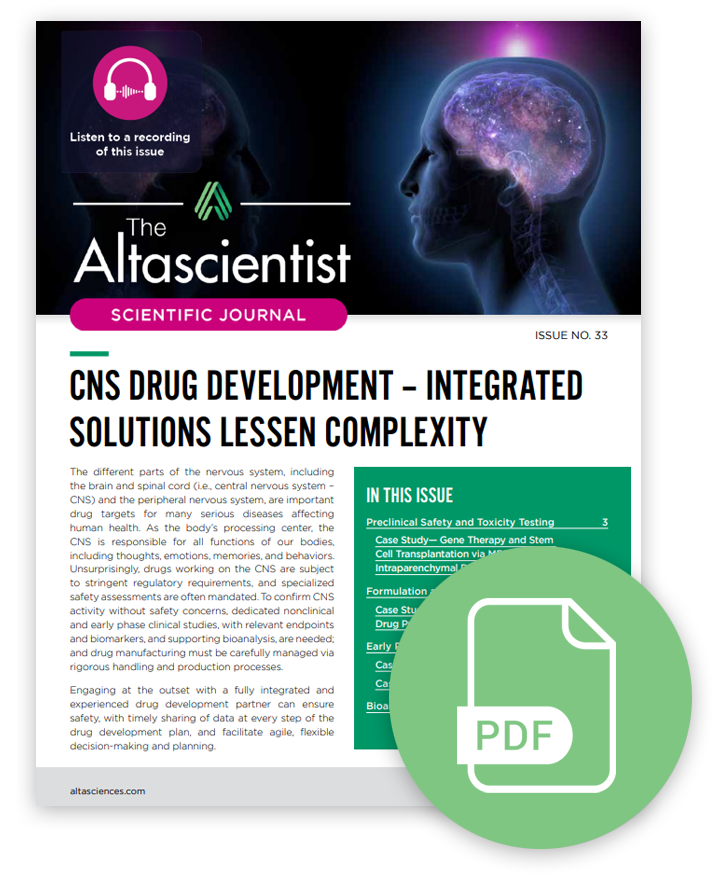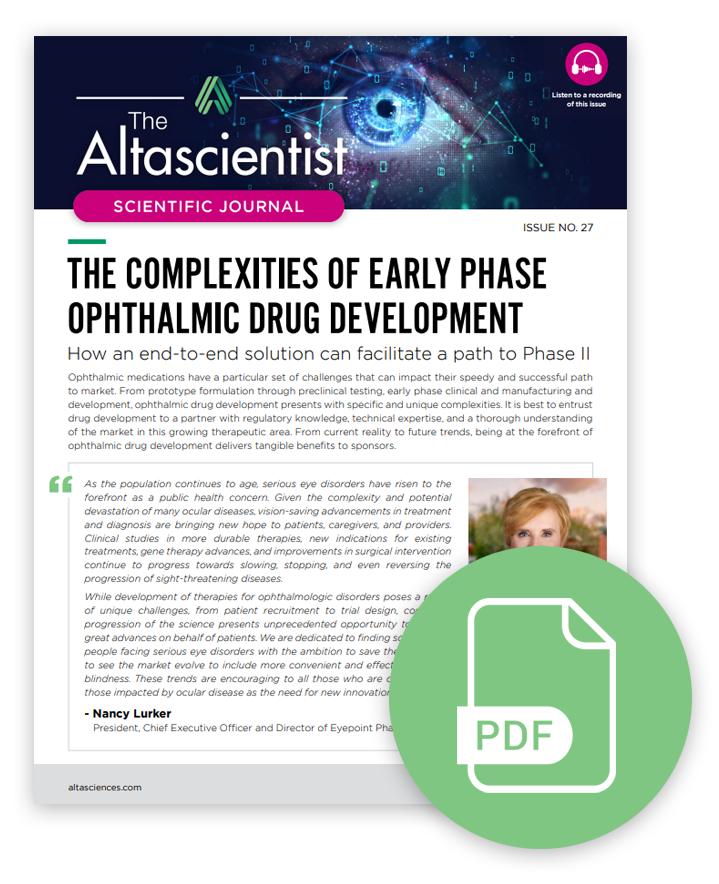End-to-End Program
4 Essential Topics to Cover in Your First CRO Meeting

ISSUE NO. 42 — Managing The Complexities of Glucagon-Like Peptide-1 Receptor Agonist Drug Development

Current and future development of glucagon-like peptide-1 receptor agonists (GLP-1 RAs), or simply GLP-1s, involves complexities not only in formulation but in all areas of early-phase drug development. Developing and refining preclinical models for early efficacy signals, developing and validating the bioanalytical assays necessary for quantitation, and designing the clinical studies that deliver the most robust data in this innovative therapeutic area are all key elements of a drug development program.
In Issue 42 of The Altascientist, we review the requirements for successful GLP-1 drug development, including:
- preclinical approaches
- early-phase clinical study design
- bioanalytical techniques
- manufacturing
Two case studies are also included.
The Golden Era of GLP-1 Drugs
GLP-1 RAs are entero-pancreatic hormone-based treatments, first approved in 2005 for type 2 diabetes (T2D), and now commonly prescribed for weight loss and reduction of atherosclerotic cardiovascular (CV) risk in patients with T2D.
According to a MarketsandMarkets report from July 2024, the global GLP-1 market is expected to reach $471 billion worldwide by 2032. More than one billion people worldwide are living with obesity, which increases their risk of major health complications, including T2D, high blood pressure, heart disease, stroke, metabolic syndrome, fatty liver diseases, some cancers, kidney disease, breathing problems, and sleep apnea. Most of these diseases are interrelated, with glycemic control and weight loss being a major factor in improving the overall health of sufferers.
“As we learn more about GLP-1 RAs, we realize that they target many organ systems, including the pancreas, the stomach, brain, heart, kidneys, immune system (due to reduced inflammation), and skeletal muscle. They help control the metabolism of white and brown adipose tissue and show positive effect in fatty liver disease (nonalcoholic steatohepatitis, or NASH),” says Dr. Gaetano Morelli, Chief Medical Officer at Altasciences.
What We Know So Far About GLP-1 RAs
GLP-1 RA head-to-head clinical studies have demonstrated that all GLP-1 RAs are effective at reducing A1C (the average amount of glucose in a person’s blood over the past three months). The initial pivotal studies that led to the first wave of GLP-1 RAs demonstrated that they work in several ways, including stimulating insulin release, slowing digestion, reducing appetite, and inhibiting glucagon release. These actions have made GLP-1 RAs excellent candidates for obesity treatment, where much of the new development is now focused. As with most medical breakthroughs, the development and implementation of GLP-1 RA drugs is not straightforward.
How Altasciences Can Help With Your GLP-1 Drug Development
Altasciences offers comprehensive services and support throughout the early phases of your GLP-1 RA drug development. We bring you expertise in preclinical studies, including custom diet-induced obesity (DIO) and other modified models; clinical trial design, conduct, and reporting; regulatory support; and bioanalytical testing.
With proactive communication and seamless handoffs, we ensure that your GLP-1 RA drug development program or study is efficiently managed. This includes optimizing study designs, managing compliance with regulatory standards like GLPs, and ensuring timely data collection and analysis. Such seamless coordination accelerates timelines, reduces costs, maximizes animal and participant safety, and ensures that the data meets the stringent requirements for regulatory approval.
Explore all issues of The Altascientist in our Resource Center. And don’t forget to subscribe to “The Altascientist: Audiobooks” on Spotify, Apple Podcasts, or wherever you get your audio content.
Five Promising Treatment Areas in Early-Phase Drug Development in 2024
Early-phase drug development is an ever-changing landscape, as emerging science leads to new promising areas of research for the treatment of human health issues. In this blog article, we review some of these areas of investigation where Altasciences has robust expertise and solution offerings.
Disrupting the CRO Model: Altasciences Participates in Documentary Series for 2024 Global Health Summit
Altasciences is leading the conversation on change in the drug development industry as part of a new documentary series for the 2024 Global Health Summit, hosted alongside the WHO’s 77th World Health Assembly in Geneva in May. The mini documentary explores transformation in the slow-to-change drug development industry.
ISSUE NO. 33 — End-to-End CNS Drug Development Solutions

In Issue 33 of The Altascientist, we explore how a comprehensive, end-to-end integrated approach to drug development for central nervous system (CNS) therapeutics can take you seamlessly from lead candidate selection to market.
Engaging at the outset with a fully integrated and experienced drug development partner can ensure safety, with timely data sharing at every step of the drug development plan, and facilitate agile, flexible decision-making and planning.
With detailed case studies, study considerations, and more, this Issue covers:
- preclinical safety and toxicity testing,
- formulation and manufacturing,
- early-phase clinical trials, and
- bioanalysis.
the cns drug development landscape
The different parts of the nervous system, including the brain and spinal cord (i.e., central nervous system – CNS) and the peripheral nervous system, are important drug targets for many serious diseases affecting human health. As the body’s processing center, the CNS is responsible for all functions of our bodies, including thoughts, emotions, memories, and behaviors.
According to Fortune Business Insights, the global CNS market is projected to grow from $89.02 billion in 2021 to $166.53 billion in 2028, at a compound annual growth rate (CAGR) of 9.4%. This growth is driven primarily by the rising demand for age-related neurodegenerative treatments due to the increasing global population over the age of 65, the growing potential of psychedelic therapies in treating conditions like PTSD and psychosis, and CNS-active drugs proving increasingly effective across various areas, such as acute and chronic pain, brain diseases, and autoimmune disorders.
“The successful delivery of drugs targeting the treatment of CNS conditions is challenged by the blood-brain barrier (BBB) and blood-cerebrospinal fluid barrier (BSCFB), which protect the CNS from intrusion by harmful substances. Large molecules are less able to penetrate the blood/brain barrier to deliver therapeutic results and thus most CNS-active drugs are small molecules.” — The Altascientist, Issue 33, pg. 2.
SPECIALIZED ASSESSMENTS AND STUDIES
Unsurprisingly, drugs working on the CNS are subject to stringent regulatory requirements, and specialized safety assessments are often mandated. To confirm CNS activity without safety concerns, dedicated nonclinical and early-phase clinical studies, with relevant endpoints and biomarkers and supporting bioanalysis, are needed, and drug manufacturing must be carefully managed via rigorous handling and production processes.
“Specialized assessments in nerve conduction are sometimes performed in CNS drug development, depending on the specifics of the new molecular entities. These key assays, performed in NHPs, can be included in preclinical safety and toxicology programs to assess the peripheral neuropathy (PN) liability of a new drug.” — The Altascientist, Issue 33 pg. 5.
The many advancements in developing CNS-active drugs have been hampered by higher failure rates compared to drug discovery in most other therapeutic domains. Identifying CNS experts with a well-established record of conducting rigorous, high-quality research can assure the effective management of challenges and reduce the risks of delaying or failing to advance promising drug candidates.
Explore all issues of The Altascientist in our Resource Center. And don’t forget to subscribe to “The Altascientist: Audiobooks” on Spotify, Apple Podcasts, or wherever you get your audio content.
Scratching the Surface of Dermal Testing
Ophthalmic End-to-End Drug Development Solutions
Altasciences' Proactive Drug Development Solution: Small Molecules
ISSUE NO. 27 — The Complexities of Early-Phase Ophthalmic Drug Development

Ophthalmic medications have a particular set of challenges that can impact their speedy and successful path to market. From prototype formulation through preclinical testing, early-phase clinical and manufacturing and development, ophthalmic drug development presents with specific and unique complexities. It is best to entrust drug development to a partner with regulatory knowledge, technical expertise, and a thorough understanding of the market in this growing therapeutic area. From current reality to future trends, being at the forefront of ophthalmic drug development delivers tangible benefits to sponsors.
In Issue 27 of The Altascientist, we dive into all areas of ophthalmic drug development, including:
• Prototype development, formulation, and manufacturing
• Preparing for first-in-human studies
• Species and strain selection parameters
• Routes of administration
• Specialized ocular assessments and equipment
• bioanalysis
• Phase I clinical research
• Phase II to commercialization
Three case studies are also included!
Navigating the Complexities of Ophthalmic Drug Development
The global market for ophthalmic drugs was valued at USD 36.7 billion in 2020, according to Grandview Research. The compound annual growth rate (CAGR) is expected to be 6.4% from 2021 to 2028. The acceleration in market growth is influenced by increasing awareness of eye-related diseases and advancements in related technology. The aging of the population, as well as the impact of COVID-19 ocular involvement, are also contributing factors. Certain ocular diseases are quite rare, whereas others, such as cataracts, age-related macular degeneration (AMD), and glaucoma, are very common, especially in the aging population.
Drug development in the ocular space has specific challenges. The eye is a multi-faceted organism and has many barriers to drug delivery. Formulation and delivery options must be expertly planned and developed to overcome those barriers and ensure that the maximum bioavailability is achieved without negatively impacting vision or the physical structure of the eye. Planning of preclinical studies must consider the appropriate animal species for the route of administration and therapeutic area of the investigational drug. Some species are more appropriate for certain routes of administration, while others have relevant retinal mutations that can be leveraged in ocular development.
Clinical trials need to be carefully designed by knowledgeable specialists with significant ophthalmic experience. The delicate nature of the eye and the importance of subject safety are key considerations. Just as importantly, the bioanalysis of trial samples necessitates the use of bioanalytical techniques created especially for the often uncommon and frequently fragile matrices involved. Finally, understanding the regulatory environment and related guidances, as well as proactive and appropriate discussions with relevant agencies when warranted, are critical components of the pathway and can help ensure a seamless experience.
Explore all issues of The Altascientist in our Resource Center. And don’t forget to subscribe to “The Altascientist: Audiobooks” on Spotify, Apple Podcasts, or wherever you get your audio content.
Download publicationOne Integrated Solution for Meeting Your Preclinical to Clinical Drug Development Needs